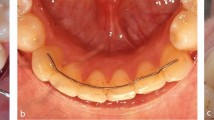Abstract
Bonded retainers may play an important role in reducing unwanted tooth movements following orthodontic treatment, with an open-ended perspective on retention now established. The importance of planning for bonded retention is emphasised, with key principles in minimising failure rates as well as wire and adhesive options discussed. Approaches to preparation of the wire and the teeth, the bonding process, as well as variations in retainer design, and means of preventing problems and undertaking repairs in order to achieve predictable fixed retention in the long term are also outlined.
Key points
-
An open-ended attitude to retention is routine, placing an onus on predictable approaches to fixed retention.
-
Fixed retention should be compatible with long-term use and optimal oral health.
-
Key underpinning principles are described, including careful planning and preparation, and meticulous technique in order to optimise long-term predictability with fixed retention.
This is a preview of subscription content, access via your institution
Access options
Subscribe to this journal
Receive 24 print issues and online access
$259.00 per year
only $10.79 per issue
Buy this article
- Purchase on Springer Link
- Instant access to full article PDF
Prices may be subject to local taxes which are calculated during checkout

















Similar content being viewed by others
References
Gravely J F. Who should practise orthodontics? Br J Orthod 1989; 16: 235-241.
Little R M. Stability and relapse of dental arch alignment. Br J Orthod 1990; 17: 235-241.
Sinclair P M, Little R M. Maturation of untreated normal occlusions. Am J Orthod 1983; 83: 114-123.
Behrents R G, Harris E F, Vaden J L, Williams R A, Kemp D H. Relapse of orthodontic treatment results: growth as an etiologic factor. J Charles H. Tweed Int Found 1989; 17: 65-80.
West K S, McNamara J A. Changes in the craniofacial complex from adolescence to midadulthood. Am J Orthod Dentofacial Orthop 1999; 115: 521-532.
Driscoll-Gilliland J, Buschang M A, Behrents R G. An evaluation of growth and stability in untreated and treated subjects. Am J Orthod Dentofacial Orthop 2001; 120: 588-597.
Al-Moghrabi D, Colonio Salazar F B, Johal A, Fleming P S. Factors influencing adherence to vacuum-formed retainer wear: A qualitative study. J Orthod 2019; 46: 212-219.
Singh P, Grammati S, Kirschen R. Orthodontic retention patterns in the United Kingdom. J Orthod 2009; 36: 115-121.
Al-Moghrabi D, Pandis N, Fleming P S. The effects of fixed and removable orthodontic retainers: a systematic review. Prog Orthod 2016; 17: 24.
Zachrisson B U. Important aspects of long-term stability. J Clin Orthod 1997; 31: 563-583.
Dahl E H, Zachrisson B U. Long-term experience with direct bonded lingual retainers. J Clin Orthod 1991; 25: 619-632.
Dunne S M, Millar B J. Effect of distance from curing light tip to restoration surface on depth of cure of composite resin. Prim Dent Care 2008; 15: 147-152.
Renkema A M, Al Assad S, Bronkhorst E, Weindel S, Katsaros C, Lisson J A. Effectiveness of lingual retainers bonded to the canines in preventing mandibular incisor relapse. Am J Orthod Dentofacial Orthop 2008; 134: 179e1-8. DOI: 10.1016/j.ajodo.2008.06.003.
Storey M, Forde K, Littlewood S J, Scott P, Luther F, Kang J. Bonded versus vacuum-formed retainers: a randomized controlled trial. Part 2: Periodontal health outcomes after 12 months. Eur J Orthod 2018; 40: 399-408.
Katsaros C, Livas C, Renkema A M. Unexpected complications of bonded mandibular lingual retainers. Am J Orthod Dentofacial Orthop 2007; 132: 838-841.
Booth F A, Edelman J M, Proffit W R. Twenty-year follow-up of patients with permanently bonded mandibular canine-to-canine retainers. Am J Orthod Dentofacial Orthop 2008; 133: 70-76
Author information
Authors and Affiliations
Corresponding author
Ethics declarations
The authors declare no conflicts of interest.
Rights and permissions
About this article
Cite this article
Kirschen, R., Littlewood, S., Blazewska-Amin, A. et al. Bonded orthodontic retention: a practical guide. Br Dent J 230, 709–716 (2021). https://doi.org/10.1038/s41415-021-2936-9
Received:
Accepted:
Published:
Issue Date:
DOI: https://doi.org/10.1038/s41415-021-2936-9



